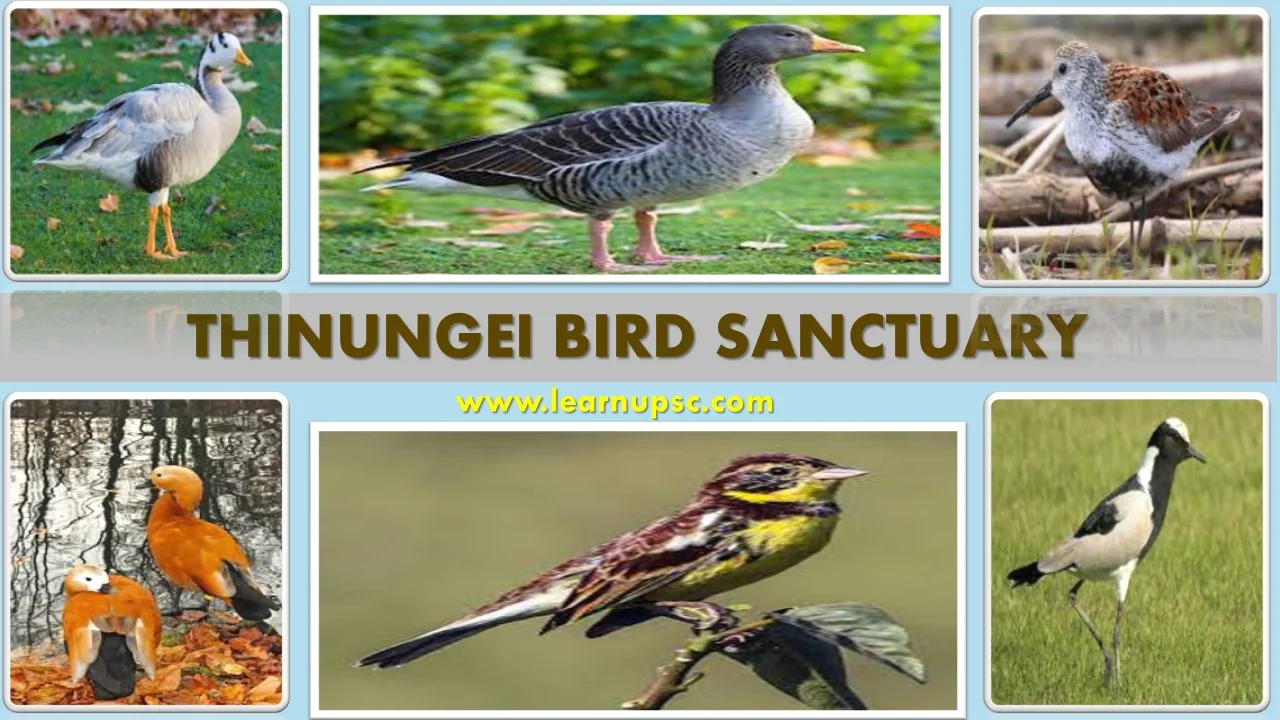Thinungei Bird Sanctuary UPSC
Thinungei Bird Sanctuary is located in the state of Manipur, sharing its western border with the famous Loktak Lake. The sanctuary consists of a mixture of swampy areas, floating biomass, and open water. It is situated in the North East Zone biogeographic zone.
The sanctuary is situated in this picturesque region, known for its scenic beauty and the conservation of various bird species, including critically endangered ones like the yellow-breasted bunting.
|
Table of Contents
|
Thinungei Bird Sanctuary Location
The Thinungei Bird Sanctuary is located in the Bishnupur district of Manipur, India. It shares its western border with the famous Loktak Lake, which is the largest freshwater lake in the Northeastern region of India.
Nearest Airport:
The nearest airport to Thinungei Bird Sanctuary is located in Imphal, Manipur. Imphal Airport is approximately 32 kilometers away from the sanctuary.
Nearest Railway Station:
As for the nearest railway stations, you have a couple of options:
Jiribam Railway Station: Jiribam is a town in Manipur, and it has a railway station. This could be one of the nearest railway stations to Thinungei Bird Sanctuary within the state of Manipur.
Dimapur Railway Station: Dimapur is located in Nagaland and is another option. It's relatively close to Manipur and provides rail connectivity.
Thinungei Bird Sanctuary History
Establishment: The Thinungei Bird Sanctuary was officially notified and established as a bird sanctuary in the year 2019. This designation is a formal recognition of the area's significance for the conservation of avian species and their habitats.
Thinungei Bird Sanctuary Area
The Thinungei Bird Sanctuary covers an area of approximately 1.031 square kilometers (103.1 hectares). This sanctuary is relatively small in size but is home to a diverse range of bird species, including both resident and migratory birds.
Thinungei Bird Sanctuary Lake
The Thinungei Bird Sanctuary is situated in the vicinity of Loktak Lake, which is the largest freshwater lake in the Northeastern region of India. While the sanctuary itself primarily consists of swampy areas, floating biomass, and open water habitats rather than being a separate lake, it is closely associated with Loktak Lake.
Loktak Lake is known for its unique phumdis, which are floating biomass masses, and it serves as an important ecosystem for various bird species, including migratory birds.
So, while the Thinungei Bird Sanctuary doesn't have its own separate lake, it is located near and shares its western border with Loktak Lake, which contributes to the rich biodiversity of the sanctuary.
The presence of Loktak Lake and its associated wetlands makes the Thinungei Bird Sanctuary an important site for bird conservation and birdwatching in the region.
Thinungei Bird Sanctuary Flora
The Thinungei Bird Sanctuary is characterized by a unique combination of flora, particularly the presence of floating biomass called "phumdi." Here are some key elements of the flora in and around the sanctuary:
(1) Phumdi (Floating Biomass):
Phumdis are the most distinctive feature of Loktak Lake, which shares its western border with the Thinungei Bird Sanctuary. These are floating masses of organic matter, including aquatic plants and soil, which form a unique ecosystem. Phumdis support various types of flora and fauna, and they are critical for the ecological balance of the area.
(2) Aquatic Plants:
In addition to phumdi, the area around the sanctuary is likely to host various aquatic plants. These may include water lilies, lotus, and other submerged or emergent aquatic vegetation that provide food and habitat for aquatic and bird species.
(3) Grasses and Reeds:
Swampy areas often have various types of grasses and reeds that contribute to the overall wetland ecosystem. These plants offer shelter and nesting sites for birds and provide a habitat for smaller aquatic organisms.
(4) Aquatic Algae:
Algae are common in wetland ecosystems and play a crucial role in the food chain, providing nourishment for various aquatic organisms.
Thinungei Bird Sanctuary Fauna (Thinungei Bird Sanctuary Animals)
The Thinungei Bird Sanctuary is home to a diverse range of fauna, particularly avian species. Here are some of the notable bird species and other fauna found in the sanctuary:
Mammals:
- Jackal
- Mongoose
- Civet
Birds:
- Nganu thangong (Ruddy shelduck)
- Lam kanga (Greylag goose)
- Yellow Breasted Bunting (Emberiza aureola)
- Kangsel (Bar headed goose)
- Darters
- Cormorants
- Gulls
- Terns
- Grebes
- Storks
- Plovers
- Lapwings
- Snipes
- Sandpipers
Reptiles:
- Tortoise
- Snakes
- Lizards


No comments:
Post a Comment